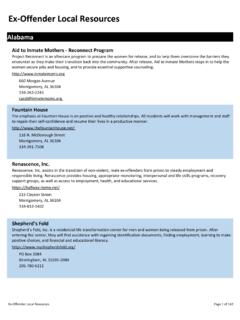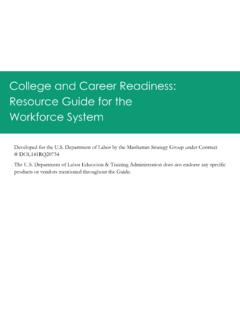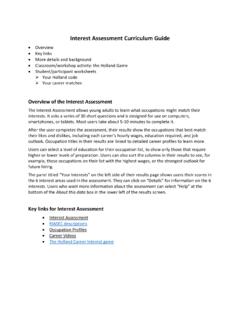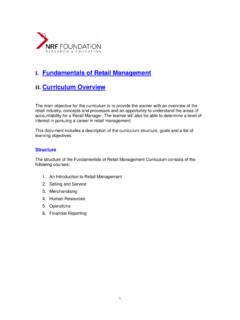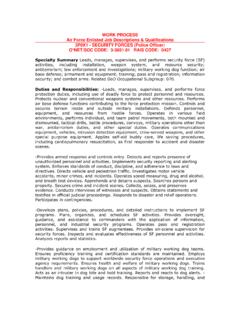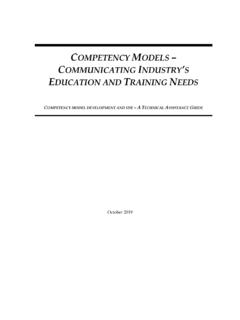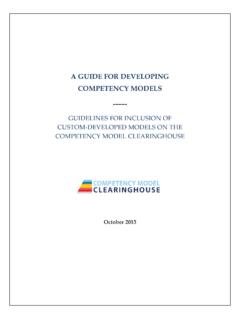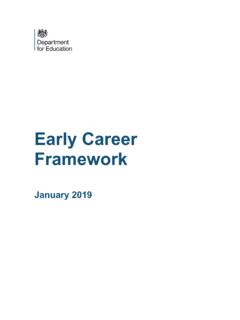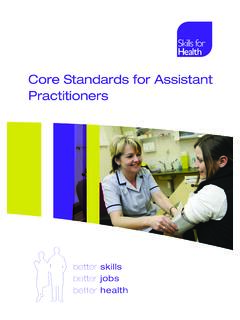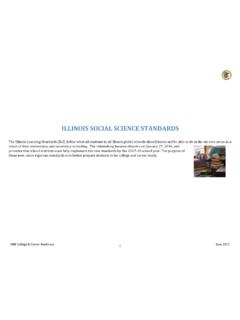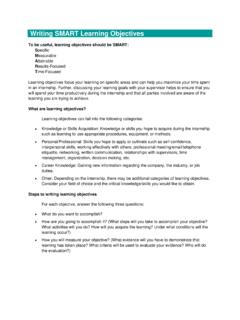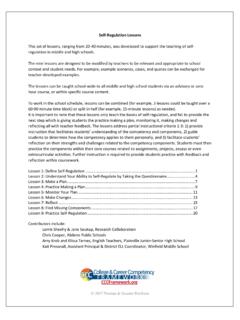Transcription of National Career Development Guidelines
1 Page National Career Development Guidelines live in a time when both youth and adults are confronted with constant change in many aspects of their lives. For example, changes in the workplace include a redistribution of available jobs, a more rapid rate of technological Development and shifts in business structure. Individuals must invest in lifelong learning to remain competitive. All of this creates the need for frequent Career decision-making and those decisions can impact on a person s family, finances, health, social responsibilities, leisure time and overall lifestyle.
2 It is clear that each person must manage his/her Career . The skills to do so can be learned through Career Development programs for youth and adults. What is Career Development ? Career Development is a lifelong process comprised of many tasks that arise in conjunction with exploring, choosing and implementing decisions about educational, occupational and related life roles. In the broadest sense, Career Development can be understood as one of the many aspects of socialization that combine to create human Development . In this case, it is that aspect of human devel-opment which includes how individuals incorporate their values about work, their beliefs about their own interests and abilities, their decisions about education, the ways they negotiate transitions into and out of work experiences and their unique interactions between work and other life roles.
3 (Herr, 2004). THE National Career Development Guidelines REVISION PROJECTThe National Career Development Guidelines ( Guidelines ) resource identifies content, provides activities and materials and recommends program implementation strategies that support the Career Development process throughout life. The Guidelines can help practitioners: prepare youth and adults for the changing workplace by increasing their understanding of the need for lifelong learning and the relationship between education and employment; reduce individual risks by promoting better understanding of self, improving social adjustment and enhancing decision-making and planning skills; increase program accountability by evaluating program process and outcomes through regular as-sessment.
4 Promote program coordination and articulation by defining a sequence of delivery for program activities, reinforcing learning from previous levels and reducing duplication of services; and expand public awareness of the need for and benefits of Career National Occupational Information Coordinating Committee (NOICC) first released the Guidelines resource in 1989. It contained a framework of Career Development competencies and indicators, as well as a recommended strategy for implementing Career Development programs for youth or adults. The GuidePage lines initiative is now funded by the US Department of Education s Office of Vocational and Adult Educa-tion (OVAE).
5 In the fifteen years since the Guidelines initial Development , much has changed. The demands of a high performance workplace require workers to engage in lifelong learning to continually improve their aca-demic, occupational and Career management skills. It is important for the Guidelines to remain dynamic and continue to reflect the full scope of Career Development and Career management skills required in today s workplace. Therefore, the Guidelines Revision Project was commissioned in 2003 to: update and revise the Guidelines framework of competencies and indicators to effectively align with the goals of No Child Left Behind (NCLB); expand the Guidelines target audiences to include K-12 students and their parents, teachers, counselors and administrators, postsecondary students and other adults, as well as the business community.
6 Broaden the Guidelines scope and application by providing the target audiences easily accessible Career Development information, learning activities and strategies that lead to informed Career decision-making and lifelong learning; and create a robust, Career Development Web site for the delivery of Guidelines information, learning activities and strategies. To accomplish this mission, OVAE contracted with DTI Associates, Inc. - A Haverstick Company (DTI) to oversee the creation of an expanded Guidelines resource that contains these components: a framework of Career Development domains, goals and indicators; Career Development activities and resources for youth and adults to use on their own or with fam-ily.
7 And Career Development lessons, activities, resources and implementation strategies for educators, administrators, counselors and Career Development practitioners to support program Development , delivery and materials in each component are designed to help youth and adults better manage their own careers or to help professionals design and deliver Career Development programs and services for youth and adults in many settings. The America s Career Resource Network (ACRN) Web site ( ) houses the components of the THE Guidelines FRAMEWORKD omains and GoalsDomains, goals and indicators organize the Guidelines framework .
8 The three domains: Personal Social Development (PS), Educational Achievement and Lifelong Learning (ED) and Career Management (CM) organize content that is further described by eleven goals. The goals define broad areas of Career develop-ment competency as shown below. Page Personal Social Development Domain GOAL PS1 Develop understanding of self to build and maintain a positive self-concept. GOAL PS2 Develop positive interpersonal skills including respect for diversity. GOAL PS3 Integrate growth and change into your Career Development . GOAL PS4 Balance personal, leisure, community, learner, family and work Achievement and Lifelong Learning Domain GOAL ED1 Attain educational achievement and performance levels needed to reach your personal and Career goals.
9 GOAL ED2 Participate in ongoing, lifelong learning experiences to enhance your ability to function effectively in a diverse and changing Management Domain GOAL CM1 Create and manage a Career plan that meets your Career goals. GOAL CM2 Use a process of decision-making as one component of Career Development . GOAL CM3 Use accurate, current and unbiased Career information during Career planning and management. GOAL CM4 Master academic, occupational and general employability skills in order to obtain, create, maintain and/or advance your employment.
10 GOAL CM5 Integrate changing employment trends, societal needs and economic conditions into your Career and Learning StagesThe goals are detailed by more than 200 indicators that highlight the knowledge and skills needed to achieve them. (Visit for a complete list of the Guidelines indicators.) Each indica-tor is presented in three learning stages derived from Bloom s Taxonomy. They represent a developmental sequence of Knowledge Acquisition, Application and Reflection (see below). The stages describe learning competency. They are not tied to an individual s age or level of education.
